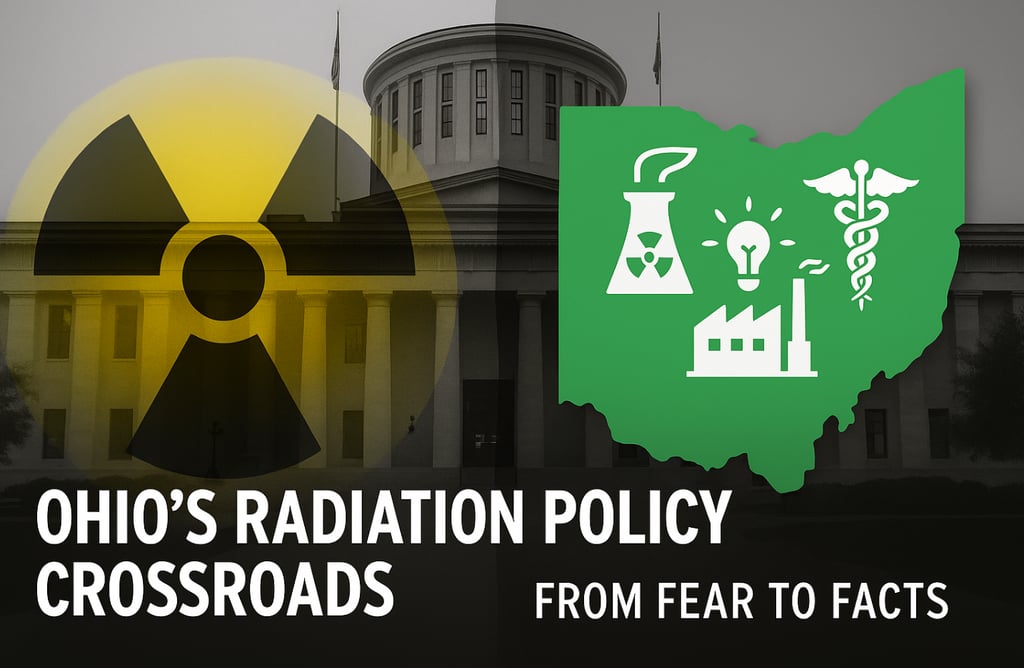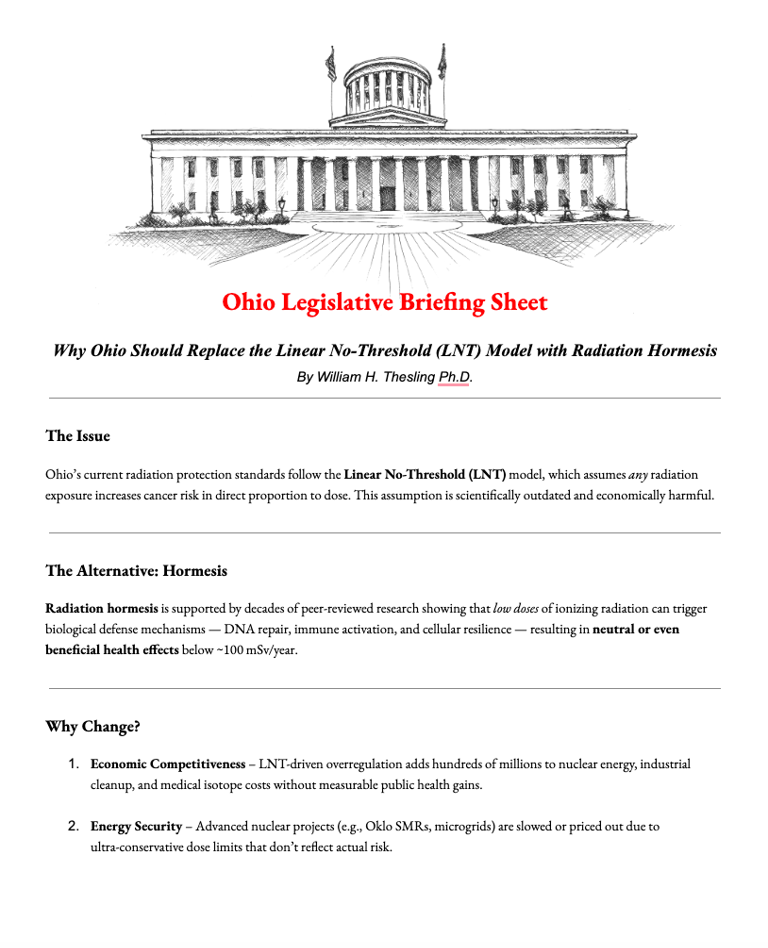Rethinking Radiation Policy in Ohio: The Case for Hormesis
Ohio still regulates radiation as if it’s 1955. The science says otherwise — low doses can be harmless, even beneficial. Clinging to the Linear No-Threshold model is stifling nuclear energy, driving up costs, and holding back medical innovation. It’s time for Ohio to embrace hormesis and lead the nation in science-based policy.
NEWS
William H. Thesling Ph.D.
8/15/20255 min read


By William H. Thesling, Ph.D.
For decades, radiation protection standards in the United States — including those applied in Ohio — have been built on the Linear No-Threshold (LNT) model, which assumes that any dose of ionizing radiation, no matter how small, increases cancer risk in direct proportion to the dose received. This premise, codified in federal guidance and reflected in state regulation, has shaped nuclear facility licensing, medical imaging policies, environmental cleanup criteria, and public perception.
However, advances in radiobiology, epidemiology, and health physics strongly suggest that the LNT model is not only outdated, but may be actively harmful to sound policy-making and technological progress. Ohio’s energy future, medical innovation potential, and even environmental remediation strategies could benefit greatly from adopting an alternative approach — the radiation hormesis model.
The Problem with LNT
The LNT model’s roots trace back to mid-20th century interpretations of genetic mutation data, extrapolated from high-dose exposures in atomic bomb survivors. The model assumed no safe threshold for radiation exposure, largely as a precautionary measure during the Cold War’s nuclear proliferation era.
But decades of research have revealed fundamental weaknesses in LNT’s assumptions:
Extrapolation Error: The LNT model takes biological effects observed at high doses (hundreds of millisieverts) and draws a straight line to zero, ignoring cellular repair mechanisms that dominate at low doses.
Lack of Low-Dose Evidence: Large-scale epidemiological studies (e.g., Canadian nuclear worker cohorts, Taiwanese apartment residents exposed to Co-60, and medical imaging patient populations) have failed to show consistent increases in cancer risk below ~100 mSv/year.
Over-Regulation Consequences: LNT’s rigidity leads to excessive safety margins, driving up costs for nuclear energy, industrial radiography, and medical isotopes, while providing negligible, if any, public health benefit.
Hormesis: A More Accurate Biological Model
Radiation hormesis recognizes that low doses of ionizing radiation can stimulate protective biological responses — such as enhanced DNA repair, upregulation of immune surveillance, and apoptosis of damaged cells — leading to net beneficial effects.
Key evidence supporting hormesis includes:
Cellular & Molecular Data: Laboratory studies consistently show biphasic dose-response curves, where low-level exposure improves cellular resilience before negative effects emerge at higher doses.
Occupational Data: Nuclear shipyard worker studies (Matanoski, 1991) and DOE facility cohorts show reduced cancer incidence compared to unexposed control populations.
Ecological Data: Natural high-background radiation areas (e.g., Ramsar, Iran; Guarapari, Brazil; Kerala, India) have populations with equal or better health metrics than global averages.
These findings are not fringe science — they have been documented in Health Physics, Radiation Research, and Dose-Response journals, and are actively discussed in professional societies such as the Health Physics Society (HPS) and the American Nuclear Society (ANS).
Policy Implications for Ohio
Abandoning LNT in favor of hormesis-based regulation would not mean disregarding radiation safety. It would mean aligning safety standards with modern science — enabling Ohio to:
Lower Nuclear Power Costs: Relaxing unnecessarily conservative cleanup and exposure limits could save hundreds of millions in decommissioning and waste management, directly benefiting ratepayers.
Accelerate Advanced Nuclear Deployment: Oklo, X-energy, and other advanced reactor developers face licensing hurdles due to LNT-driven dose constraints that make even trivial environmental releases politically toxic.
Improve Medical Access: Radiopharmaceutical development, PET scanning, and cancer therapy could proceed with fewer cost and regulatory burdens, expanding Ohio’s biomedical competitiveness.
Rationalize Environmental Cleanup: Hormesis-based thresholds would avoid multi-billion-dollar “as low as reasonably achievable” (ALARA) cleanups of lightly contaminated industrial sites that pose no measurable risk.
The Implementation Path
Ohio can lead nationally by:
Commissioning a State Scientific Review Board to assess hormesis literature and provide updated dose-response guidelines.
Adjusting State Dose Limits upward to levels supported by international hormesis data (e.g., 50–100 mSv/year for occupational exposure, 10–20 mSv/year for the public).
Coordinating with Federal Agencies like DOE and NRC to request variances or pilot regulatory frameworks for state-managed sites and operations.
Public Engagement campaigns to counter decades of fear-based messaging about “zero safe dose.”
Conclusion
The LNT model was adopted in an era of scientific uncertainty and geopolitical fear. Today, it survives more from institutional inertia than from empirical validity. Ohio has an opportunity to break from this outdated paradigm, embrace hormesis, and build a more scientifically sound, economically competitive, and socially responsible radiation policy.
By doing so, Ohio could simultaneously strengthen its energy security, advance its biomedical sector, and establish itself as a national leader in rational, evidence-based regulation.
Appendix: Ten Strongest Peer-Reviewed Studies Supporting Radiation Hormesis
Compiled by William H. Thesling, Ph.D.
1. Chen WL, et al. (2007) – Taiwan Co-60 Contaminated Apartments Study
Journal: International Journal of Radiation Biology
Summary: Over 10,000 residents exposed to chronic low-dose gamma radiation (average 0.4 Sv/year) from cobalt-60 contaminated steel. Residents had significantly lower overall cancer mortality than the general population, despite lifetime exposures exceeding “safe” LNT limits.
Relevance to Ohio: Demonstrates that chronic low-dose exposure can correlate with improved health outcomes in a large, real-world population.
2. Matanoski GM, et al. (1991) – Nuclear Shipyard Worker Study
Journal: Johns Hopkins University Applied Physics Laboratory Report
Summary: Compared 28,000 nuclear shipyard workers exposed to low-dose radiation with 33,000 unexposed controls. Exposed workers had lower mortality rates from all cancers combined.
Relevance to Ohio: Occupational dose limits can be set higher without compromising worker health.
3. Luckey TD (1991) – Hormesis and Public Health
Journal: Health Physics
Summary: A synthesis of over 1,000 studies showing biphasic dose-responses in mammals, with improved health markers at doses below ~100 mSv/year.
Relevance to Ohio: Foundational literature supporting a safe exposure threshold above current LNT-based limits.
4. Cohen BL (1995) – Radon and Lung Cancer in U.S. Counties
Journal: Health Physics
Summary: Studied radon levels and lung cancer mortality across 1,600 U.S. counties. Found a negative correlation between radon concentration and lung cancer mortality — contradicting LNT predictions.
Relevance to Ohio: Radon risk management could be reframed, reducing unnecessary mitigation costs in low- to moderate-level areas.
5. Jaworowski Z (2000) – Radiation Risk and Ethics
Journal: Physics Today
Summary: Analyzed global data on background radiation and nuclear industry exposures, concluding that LNT overstates risk and suppresses beneficial radiation uses.
Relevance to Ohio: Supports policy reform in nuclear licensing, cleanup standards, and public communication.
6. Pollycove M, Feinendegen LE (2003) – Biological Mechanisms of Radiation Hormesis
Journal: American Journal of Clinical Oncology
Summary: Detailed the molecular and cellular mechanisms of low-dose radiation–induced adaptive protection, including DNA repair and immune modulation.
Relevance to Ohio: Provides mechanistic evidence to justify regulatory changes and defend them in court.
7. Sanders CL (2010) – Radiobiology and Radiation Hormesis
Publisher: Springer-Verlag
Summary: Comprehensive review of animal and human data showing reduced cancer rates and increased longevity at low-dose exposures.
Relevance to Ohio: Serves as a scientific backbone for legislative testimony.
8. Tubiana M, et al. (2009) – Low-Dose Radiation: Myths and Realities
Journal: Radiology
Summary: Review by French Academy of Sciences and National Academy of Medicine concluding that risks below 100 mSv are unproven and that hormesis is consistent with much of the data.
Relevance to Ohio: Supports threshold-based regulatory models consistent with European best practice.
9. Feinendegen LE, et al. (2013) – Adaptive Response and Health Effects
Journal: Radiation Research
Summary: Summarized cellular adaptive responses to low-dose radiation in human and animal models, showing net beneficial effects for health.
Relevance to Ohio: Reinforces that LNT ignores protective biological processes, leading to overregulation.
10. Calabrese EJ, Baldwin LA (2000) – Radiation Hormesis: Historical Foundations
Journal: Human & Experimental Toxicology
Summary: Traced hormesis research history, highlighting how LNT adoption was more political than scientific, and how early data supported biphasic responses.
Relevance to Ohio: Gives lawmakers historical context for why LNT persists despite contradictory evidence.
Final Note for Policymakers
These studies form a multi-disciplinary body of evidence — epidemiological, experimental, mechanistic, and historical — that collectively undermine the LNT model and support a threshold or hormetic approach to radiation regulation.
Ohio could leverage this literature to:
Justify regulatory variance petitions to the NRC and DOE.
Support state-level occupational dose reforms.
Defend legal challenges from anti-nuclear activists.




